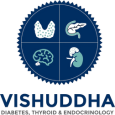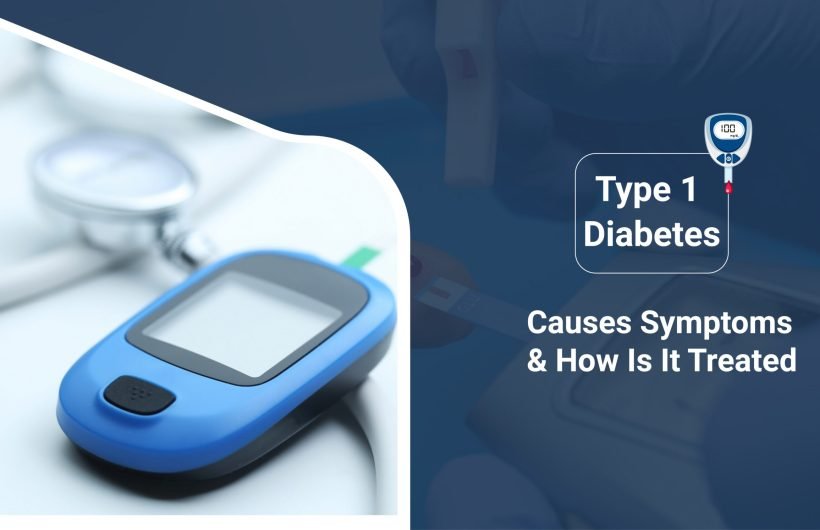Embark on a scientific journey with us as we delve into the intricate realm of Type 1 Diabetes. This blog is your gateway to understanding the profound complexities underlying this autoimmune phenomenon. We invite you to explore the enigma of Type 1 Diabetes causes, unraveling the delicate interplay between genetic susceptibilities and environmental triggers that converge to instigate an immune system onslaught against insulin-producing pancreatic beta cells. As we traverse the terrain of medical insight, we’ll meticulously dissect Type 1 Diabetes symptoms, ranging from metabolic disturbances like hyperglycemia to the telltale signs of excessive thirst and frequent urination. Beyond elucidating the condition’s fundamental aspects, we’ll meticulously scrutinize the ever-evolving landscape of Type 1 Diabetes treatment strategies. From traditional exogenous insulin administration to cutting-edge immunotherapies, join us in uncovering the arsenal of approaches aimed at ameliorating the lives of those affected by this intricate disorder.
What is Type 1 diabetes and what are the concepts necessary to understand it?
Type 1 Diabetes Overview:
- Type 1 Diabetes, also known as insulin-dependent diabetes or juvenile diabetes, is a chronic metabolic disorder characterized by the immune-mediated destruction of insulin-producing beta cells within the pancreatic islets of Langerhans.
- It results in an absolute deficiency of insulin, a hormone essential for regulating blood glucose levels and facilitating glucose uptake into cells.
Autoimmune Etiology:
- Type 1 Diabetes is primarily driven by an autoimmune response, where the immune system mistakenly targets and destroys the body’s own pancreatic beta cells.
- Genetic susceptibility plays a pivotal role, with specific human leukocyte antigen (HLA) genes conferring varying degrees of risk.
- Environmental triggers, such as viral infections, are thought to interact with genetic predispositions, precipitating the immune system’s assault on beta cells.
Insulin Deficiency and Hyperglycemia:
- With the decline in functional beta cells, insulin production diminishes significantly, leading to an imbalance in blood glucose levels.
- Elevated blood glucose, or hyperglycemia, results from the inability of cells to efficiently uptake glucose from the bloodstream, contributing to a myriad of metabolic disruptions.
Clinical Presentation:
- The onset of Type 1 Diabetes is often abrupt, characterized by symptoms such as excessive thirst (polydipsia), frequent urination (polyuria), and unintentional weight loss.
- Profound hyperglycemia can lead to fatigue, blurred vision, and increased susceptibility to infections.
Diagnosis and Distinguishing Factors:
- Diagnosis typically involves assessing blood glucose levels, with a fasting plasma glucose ≥126 mg/dL or a random plasma glucose ≥200 mg/dL serving as indicative thresholds.
- Distinguishing factors from Type 2 Diabetes include age of onset (usually in children and young adults), absence of insulin resistance, and a propensity for rapid progression to severe symptoms.
Mechanisms of Hyperglycemia:
- Insulin deficiency leads to impaired glucose uptake into cells, resulting in elevated blood glucose levels.
- The liver responds to low insulin levels by increasing glucose production through glycogenolysis and gluconeogenesis.
Long-Term Complications:
- Chronic hyperglycemia contributes to microvascular complications such as diabetic nephropathy (kidney disease), neuropathy (nerve damage), and retinopathy (vision impairment).
- Macrovascular complications include an increased risk of cardiovascular diseases.
6 causes of Type 1 Diabetes
- Genetic Susceptibility:
- Type 1 Diabetes is intrinsically linked to genetic predisposition, primarily mediated by specific human leukocyte antigen (HLA) genes.
- HLA class II genes, particularly HLA-DR and HLA-DQ, are associated with increased risk. Variations in these genes influence the immune system’s response to self-antigens, including beta cells.
- Autoimmune Dysfunction:
- The fundamental cause of Type 1 Diabetes lies in an autoimmune response, where the immune system erroneously identifies pancreatic beta cells as foreign and launches an attack.
- Genetic susceptibility sets the stage, but environmental factors are crucial triggers.
- Environmental Triggers:
- Viral infections, especially enteroviruses like Coxsackievirus, have been implicated in the initiation of Type 1 Diabetes in genetically predisposed individuals.
- These viruses might stimulate the immune system, causing it to target beta cells as a result of molecular mimicry or other mechanisms.
- Immunological Process:
- In genetically susceptible individuals, the autoimmune response involves T cells recognizing beta-cell antigens as foreign and attacking them.
- Autoantibodies against specific beta cell antigens, such as insulin, glutamic acid decarboxylase (GAD), and islet antigen-2 (IA-2), can be detected in the preclinical phase.
- Insulitis and Beta Cell Destruction:
- As the immune response intensifies, lymphocytes infiltrate the pancreatic islets, leading to insulitis—an inflammation of the islets of Langerhans.
- This insulitis results in progressive beta-cell destruction, compromising insulin production.
- Loss of Self-Tolerance:
- The development of Type 1 Diabetes signifies a breakdown in the body’s ability to maintain self-tolerance, wherein the immune system should distinguish between self and non-self.
- Genetic and environmental factors likely disrupt immune tolerance mechanisms, leading to the immune system’s attack on beta cells.
An explanation of the symptoms of Type 1 Diabetes
- Hyperglycemia-Associated Symptoms:
- Type 1 Diabetes manifests prominently through symptoms rooted in the disruption of glucose homeostasis.
- Hyperglycemia, or elevated blood glucose levels, leads to classic signs such as excessive thirst (polydipsia) and frequent urination (polyuria).
- These symptoms result from the kidneys’ efforts to eliminate excess glucose through urine, dragging water along and causing increased thirst and urination.
- Unintentional Weight Loss:
- Individuals with Type 1 Diabetes may experience unexplained weight loss despite maintaining a normal or increased appetite.
- Weight loss occurs due to the body’s inability to utilize glucose for energy, leading to muscle breakdown and fat metabolism.
- Fatigue and Weakness:
- Chronic hyperglycemia leads to energy deprivation in cells, contributing to persistent fatigue and a sense of weakness.
- The lack of glucose uptake by cells impairs their ability to perform optimally.
- Blurry Vision:
- Fluctuations in blood glucose levels can cause changes in the shape of the lens within the eye, leading to blurred vision.
- High blood glucose levels can cause fluid to shift into the lens, altering its focusing ability.
- Increased Susceptibility to Infections:
- Elevated blood glucose levels can impair the immune system’s ability to function effectively, rendering individuals more susceptible to infections.
- Recurrent infections, particularly in the urinary tract, skin, and respiratory system, can be indicative of uncontrolled diabetes.
- Ketosis and Diabetic Ketoacidosis (DKA):
- In severe cases of untreated or inadequately managed Type 1 Diabetes, the body may resort to using fat for energy, resulting in the release of ketones.
- Ketones are acidic molecules that can accumulate in the blood, leading to a life-threatening condition called diabetic ketoacidosis (DKA).
- Symptoms of DKA include vomiting, abdominal pain, fruity-smelling breath, and rapid breathing.
- Thirst and Dehydration:
- Excessive urination, coupled with high blood glucose levels, can lead to dehydration.
- Dehydration triggers an unquenchable thirst (polydipsia) as the body attempts to restore fluid balance.
Everything to know about the treatment of type 1 diabetes
- Insulin Replacement Therapy:
- The cornerstone of Type 1 Diabetes management is exogenous insulin administration, replacing the deficient insulin production due to beta cell destruction.
- Various insulin formulations are available, categorized by their onset, peak, and duration of action, allowing for tailored therapy based on individual needs.
- Blood Glucose Monitoring:
- Regular monitoring of blood glucose levels is essential for optimizing insulin dosages and maintaining stable glycemic control.
- Continuous glucose monitoring (CGM) systems provide real-time glucose readings, aiding in better glucose management and treatment adjustments.
- Carbohydrate Counting and Meal Planning:
- Patients are often educated about carbohydrate counting to match insulin doses with their carbohydrate intake.
- Balancing meals and insulin doses helps manage post-meal blood glucose spikes.
- Insulin Delivery Methods:
- Insulin can be administered via injections using syringes, insulin pens, or insulin pumps.
- Insulin pumps provide a continuous basal insulin infusion, with bolus doses delivered before meals to cover carbohydrate intake.
- Lifestyle Management:
- Regular physical activity and exercise can improve insulin sensitivity and contribute to better glycemic control.
- A balanced diet with appropriate carbohydrate intake, along with monitoring blood glucose responses, aids in preventing extreme fluctuations.
- Emergency Preparedness:
- Individuals with Type 1 Diabetes should be educated about recognizing and managing hypoglycemia (low blood sugar) and hyperglycemia.
- In case of severe hypoglycemia or ketoacidosis, having glucagon or a plan for immediate medical intervention is crucial.
- Emerging Therapies:
- Research is ongoing to develop advanced treatment strategies such as closed-loop systems (artificial pancreas), which automate insulin delivery based on real-time glucose levels.
- Immunotherapies aimed at preserving beta cell function are also under investigation.
- Psychosocial Support:
- Managing Type 1 Diabetes involves not only physiological adjustments but also emotional and psychological well-being.
- Psychosocial support and education help individuals and their families cope with the challenges of the condition.
Conclusion
In essence, Type 1 Diabetes emerges as a complex interplay of genetic predisposition and environmental triggers, culminating in an autoimmune assault on pancreatic beta cells. The resulting insulin deficiency leads to a constellation of symptoms, including hyperglycemia-associated manifestations, unintentional weight loss, and increased vulnerability to infections. The cornerstone of management revolves around exogenous insulin therapy, blood glucose monitoring, and lifestyle adjustments such as carbohydrate counting and exercise. As we navigate this intricate landscape of causes, symptoms, and treatment, it becomes evident that understanding the dynamics of Type 1 Diabetes empowers individuals to navigate their health journey with resilience and informed choices. Dr. Moxit Shah a dedicated advocate in the field of endocrinology, underscores the importance of tailored treatment strategies and ongoing research to enhance the lives of those grappling with this multifaceted condition.






